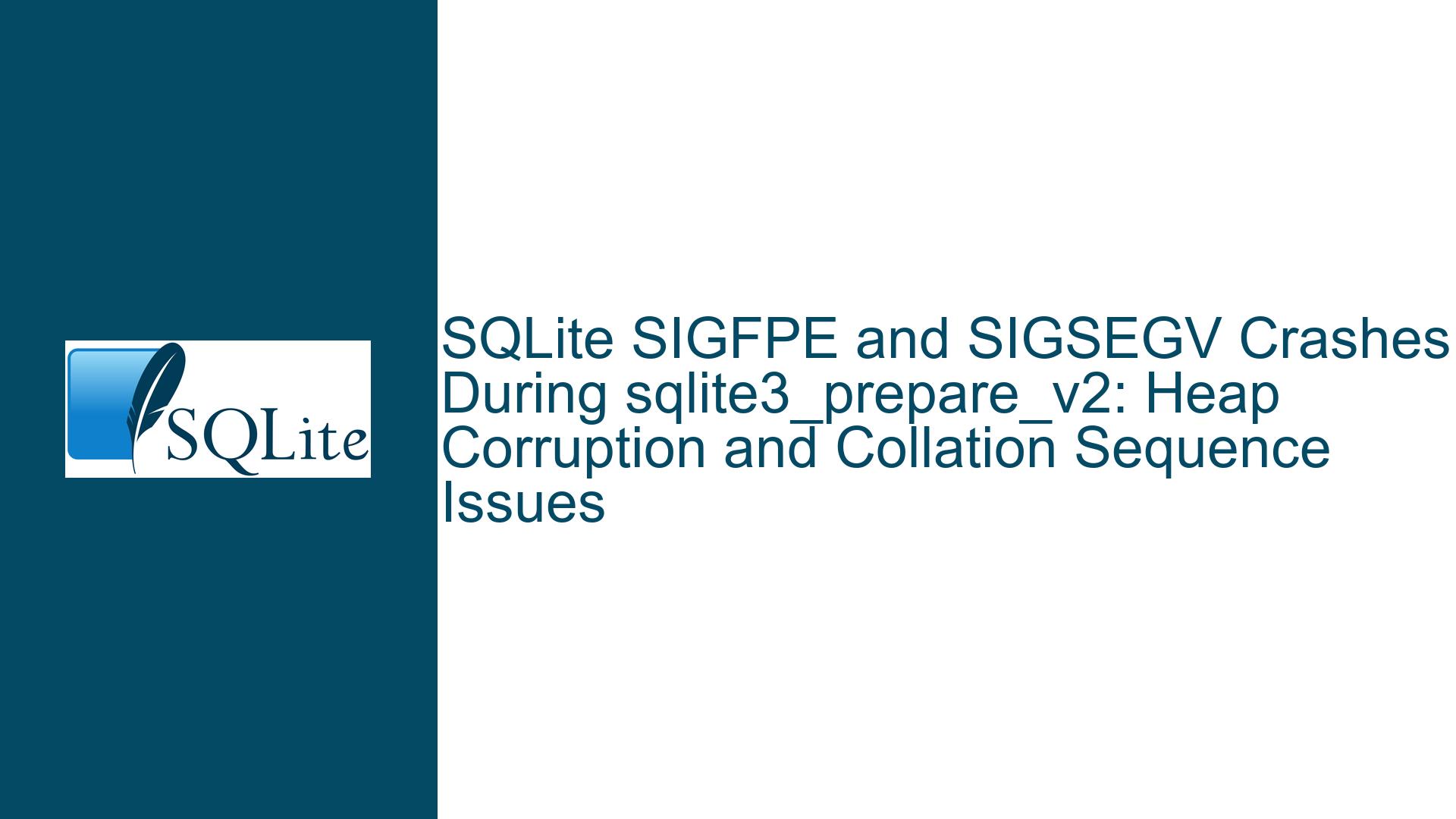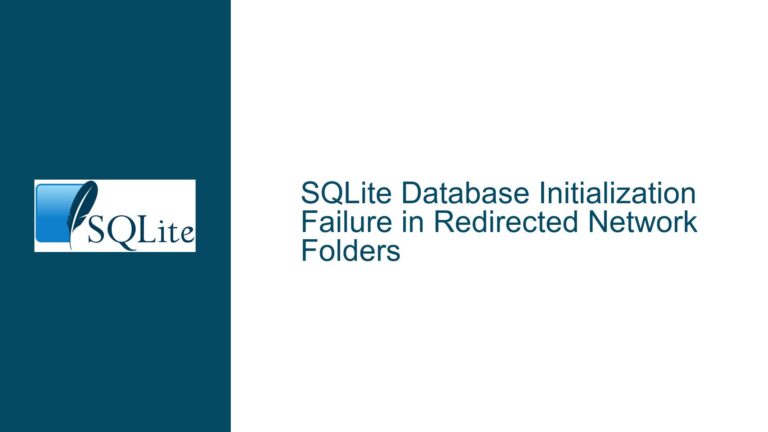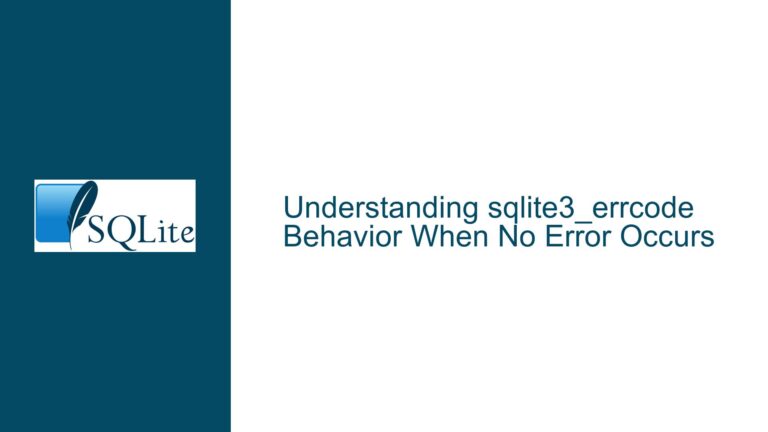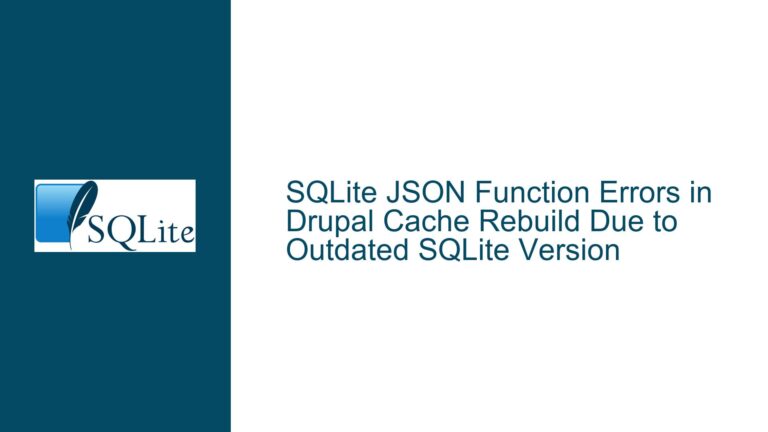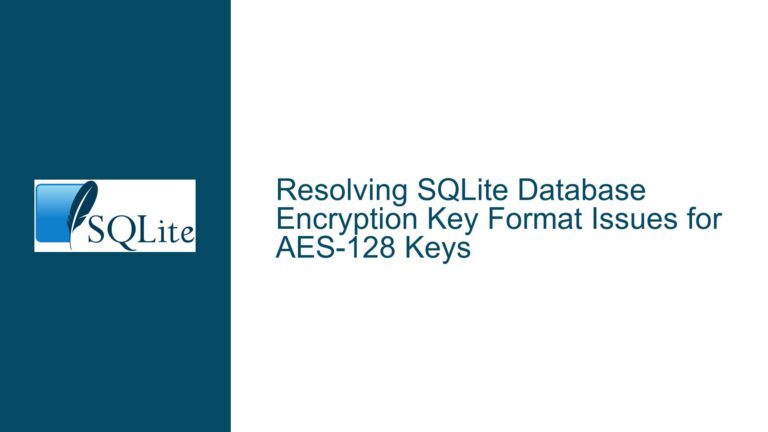SQLite SIGFPE and SIGSEGV Crashes During sqlite3_prepare_v2: Heap Corruption and Collation Sequence Issues
SQLite3_prepare_v2 Crashes with SIGFPE and SIGSEGV Signals
The core issue revolves around intermittent crashes occurring during the execution of sqlite3_prepare_v2 in SQLite version 3.31.01. These crashes manifest as two distinct signals: SIGFPE (Arithmetic Exception) and SIGSEGV (Segmentation Fault). The crashes are not consistent and occur sporadically, making them particularly challenging to diagnose. The crashes are observed when executing specific SQL queries involving collation sequences (COLLATE NOCASE) and string manipulation functions (UPPER).
The backtraces from the crashes point to two primary functions in SQLite’s internal implementation: findElementWithHash and sqlite3StrICmp. These functions are part of SQLite’s hash table and string comparison mechanisms, respectively. The crashes occur when these functions attempt to access or manipulate memory that is either invalid or corrupted. The intermittent nature of the crashes suggests that the underlying issue is not directly related to SQLite’s code but rather to external factors such as heap corruption or memory mismanagement in the application using SQLite.
The queries involved in the crashes are relatively straightforward and do not involve complex or untested SQL constructs. For example, the first query involves a SELECT statement with a COLLATE NOCASE clause, while the second query uses the UPPER function for case-insensitive comparison. Both queries are commonly used and well-tested in SQLite, further indicating that the issue lies outside the SQLite library itself.
Heap Corruption and Collation Sequence Lookup Failures
The root cause of the crashes can be traced to two primary factors: heap corruption and collation sequence lookup failures. Heap corruption occurs when the application’s memory management is flawed, leading to invalid memory accesses, double frees, or buffer overflows. Collation sequence lookup failures occur when SQLite attempts to find or use a collation sequence (such as NOCASE) that is either missing or corrupted.
Heap Corruption
Heap corruption is a common issue in applications that manage memory manually or use complex data structures. In this case, the application using SQLite is likely corrupting the heap, which in turn affects SQLite’s internal data structures. The corruption can manifest in various ways, such as:
- Double Free: Freeing the same memory block twice, leading to undefined behavior when the memory is reused.
- Use After Free: Accessing memory after it has been freed, which can result in crashes or data corruption.
- Buffer Overflow: Writing data beyond the allocated memory block, potentially overwriting critical data structures.
The intermittent nature of the crashes is a strong indicator of heap corruption. When the heap is corrupted, the symptoms may not appear immediately but can surface later when the corrupted memory is accessed or manipulated. This explains why the crashes occur sporadically and are not consistently reproducible.
Collation Sequence Lookup Failures
Collation sequences in SQLite are used to define how strings are compared and sorted. The NOCASE collation sequence, for example, performs case-insensitive comparisons. When SQLite encounters a COLLATE NOCASE clause in a query, it looks up the corresponding collation sequence in its internal hash table. If the lookup fails due to a corrupted hash table or missing collation sequence, SQLite may crash with a SIGFPE or SIGSEGV signal.
The backtrace from the crash shows that the failure occurs in the findElementWithHash function, which is responsible for locating elements in SQLite’s hash table. The hash table is used to store various internal objects, including collation sequences. If the hash table is corrupted, the lookup operation may fail, leading to a crash.
Diagnosing and Resolving Heap Corruption and Collation Sequence Issues
To address the crashes, a systematic approach is required to diagnose and resolve both heap corruption and collation sequence lookup failures. The following steps outline the troubleshooting process:
Step 1: Instrument the Application for Heap Usage Analysis
The first step is to instrument the application using tools that can detect heap corruption. Tools such as Valgrind, AddressSanitizer, and Electric Fence can help identify memory management issues such as double frees, use-after-free errors, and buffer overflows. These tools work by monitoring memory allocations and deallocations, and they can pinpoint the exact location in the code where the corruption occurs.
For example, using Valgrind, you can run the application with the following command:
valgrind --tool=memcheck --leak-check=full ./your_application
Valgrind will generate a detailed report of memory errors, including invalid memory accesses, memory leaks, and heap corruption. The report will help you identify the specific code paths that are causing the corruption.
Step 2: Verify Collation Sequence Registration
The next step is to ensure that the collation sequences used in the queries are properly registered with SQLite. Collation sequences must be registered before they can be used in queries. If a collation sequence is missing or not registered correctly, SQLite may crash when attempting to use it.
To verify the registration of collation sequences, you can use the sqlite3_create_collation function. This function allows you to register custom collation sequences with SQLite. For example, to register the NOCASE collation sequence, you can use the following code:
sqlite3_create_collation(db, "NOCASE", SQLITE_UTF8, NULL, nocase_collation);
In this example, nocase_collation is a callback function that implements the case-insensitive comparison logic. If the NOCASE collation sequence is already registered, you should ensure that the registration is not being overwritten or corrupted by other parts of the application.
Step 3: Implement Robust Error Handling
To prevent crashes caused by collation sequence lookup failures, you should implement robust error handling in your application. SQLite provides several mechanisms for error handling, including return codes and error messages. When executing SQL queries, you should always check the return codes and handle errors appropriately.
For example, when preparing a SQL statement using sqlite3_prepare_v2, you should check the return code and handle any errors:
int rc = sqlite3_prepare_v2(db, sql_query, -1, &stmt, NULL);
if (rc != SQLITE_OK) {
fprintf(stderr, "SQL error: %s\n", sqlite3_errmsg(db));
// Handle the error
}
By implementing robust error handling, you can prevent crashes caused by missing or corrupted collation sequences.
Step 4: Use PRAGMA Statements to Enhance Stability
SQLite provides several PRAGMA statements that can enhance the stability of your application. For example, the PRAGMA integrity_check statement can be used to verify the integrity of the database. This statement checks for corruption in the database file and reports any issues.
To perform an integrity check, you can execute the following SQL statement:
PRAGMA integrity_check;
If the database is corrupted, SQLite will return a detailed error message describing the issue. You can use this information to repair or restore the database.
Step 5: Perform Regular Database Maintenance
Regular database maintenance can help prevent issues such as heap corruption and collation sequence lookup failures. Maintenance tasks include vacuuming the database, rebuilding indexes, and backing up the database.
For example, you can use the VACUUM command to rebuild the database file and remove unused space:
VACUUM;
This command can help prevent fragmentation and corruption in the database file. Additionally, you should regularly back up the database to ensure that you can recover from any corruption or data loss.
Step 6: Update to the Latest Version of SQLite
Finally, you should ensure that you are using the latest version of SQLite. Newer versions of SQLite include bug fixes, performance improvements, and new features that can help prevent crashes and other issues. You can download the latest version of SQLite from the official website: https://www.sqlite.org/download.html.
By following these steps, you can diagnose and resolve the crashes caused by heap corruption and collation sequence lookup failures. The key is to systematically identify and address the root causes of the issues, ensuring that your application remains stable and reliable.
In conclusion, the crashes observed during sqlite3_prepare_v2 are primarily caused by heap corruption and collation sequence lookup failures. By instrumenting the application for heap usage analysis, verifying collation sequence registration, implementing robust error handling, using PRAGMA statements, performing regular database maintenance, and updating to the latest version of SQLite, you can effectively resolve these issues and ensure the stability of your application.
